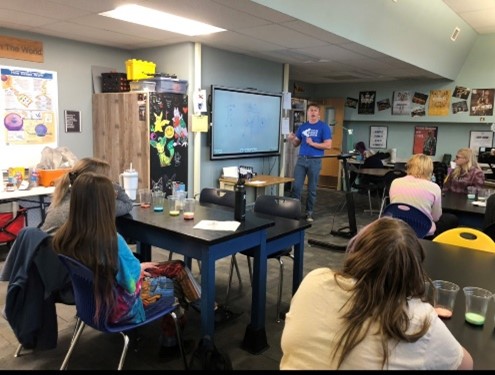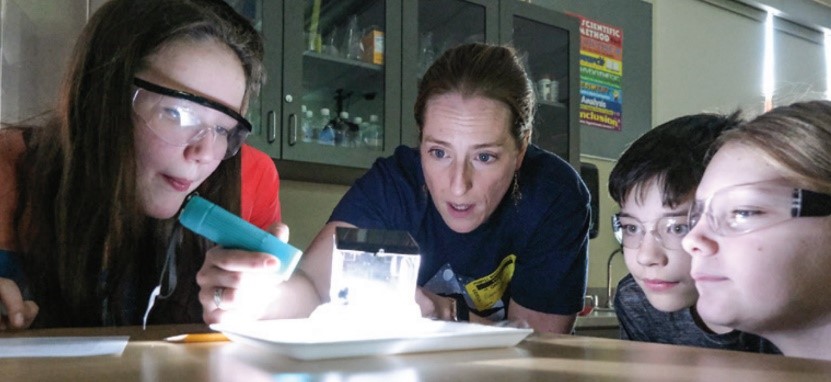Contact Us
UW Science Initiative Engagement
Karagh Brummond
Email: kmurph17@uwyo.edu
Erin Klauk
Email: eklauk@uwyo.edu
Laramie, WY 82071
2022-23 K-12 SI Roadshow Highlights
Heart Mountain Academy Cody
On Tuesday, April 18th the Roadshow crew hit the highway and headed up to Cody, Wyoming to visit with 43 high school students at Heart Mountain Academy. The students in two of the class period were learning about cell structure and function while the students in the other classes have been preparing for their project-based class on projectile motion. Therefore, the Roadshow sent two top undergraduates to Cody, Austin who has a background in mechanical engineering and physics and Max who is graduating with his molecular biology degree this spring. Max led the first set of students through concepts of molecular biology by focusing on enzymes. The students were able to do a yeast catalyst activity where they learned about how a yeast and hydrogen peroxide reaction occurs because of enzymes. The students then expanded on the idea of enzymes by doing a pineapple activity where they mixed room temperature and heated pineapple juice with milk. Lastly, the students did a cracker activity where they learned about the enzymes involved in the breakdown of food in their mouths.
Austin worked with the other set of students having them explore the concept of projectile motion. They started by discussing the importance of understanding and being able to calculate projectile motion through examples of landing spacecraft to rescuing stranded hikers in the mountains. The students talked about the terms potential and kinetic energy before doing a warm up activity where they got to research why golf balls are dimpled. The students then each built their own paper footballs and performed calculations to determine the velocity of the football in the air as it relates to projectile motion. For the main activity, the students split into groups and were able to use the EV3 LEGO catapult build (compliments of the College of Education) to launch different types of balls and perform calculations related to projectile motion. They did launching practice runs and were then given the challenge of trying to precisely hit a target by calculating first and launching second. This gave them the real-world simulation of how we can use projectile motion in different ways.
****************************************************************************************************
Roadshow Team:
Austin Bernard (Undergraduate Student Mechanical Engineering)
Max Packebush (Undergraduate Student Molecular Biology)
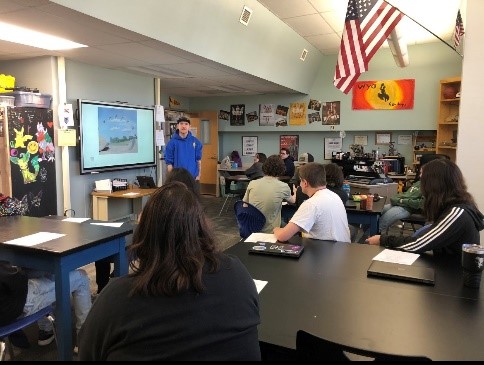 |
|
|
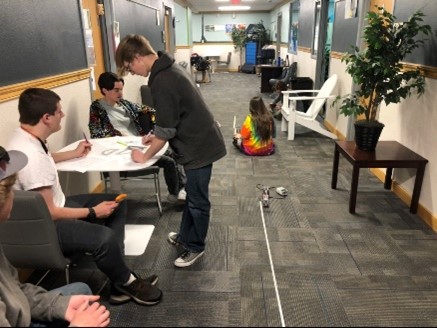 |
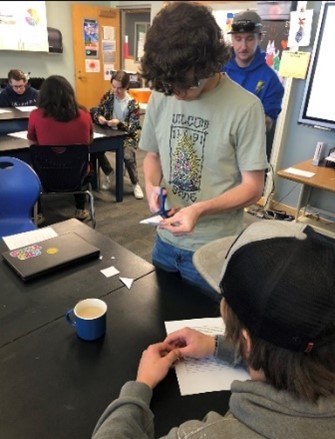 |
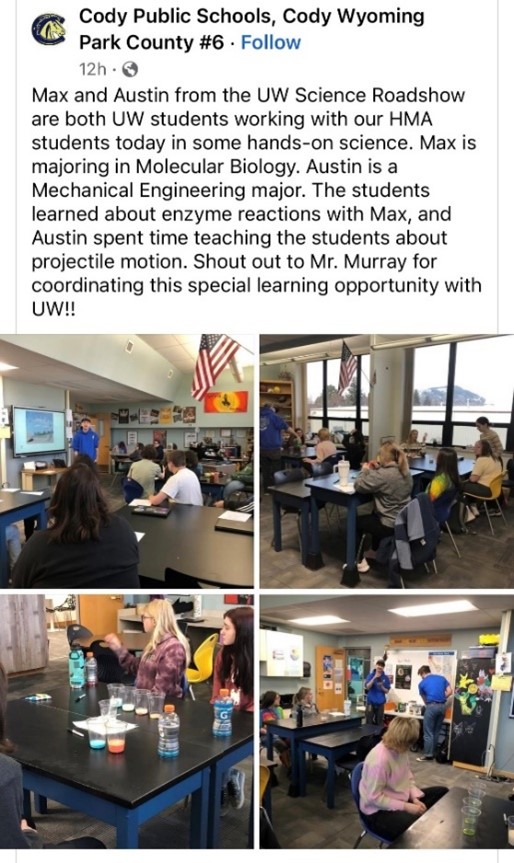
Laramie High School Earth Science
This spring the Roadshow was back with the Earth Science students at the Laramie High School! This time, 225 students were able to expand on their classroom knowledge of the carbon cycle and climate change by learning about ocean acidification. The students began by talking about the terms ocean acidification and what they mean. We then played a DIY Kahoot to identify different carbon sources and sinks that are present in the world. This really helped the students expand their knowledge on the carbon cycle, while considering where the majority of carbon sources and sinks are located. After this activity, the students started to explore the concept of pH and acidity by testing the pH of common household solutions with litmus paper. The students first worked together to predict which solutions would be most to least acidic and then tested them with the pH paper. We talked about how the results changed their predictions and re-ordering of the solutions. The Roadshow team then helped the students link the concepts of carbon, specifically carbon dioxide, with pH by performing a phenol red experiment where the students were given a cup of water with a small bit of phenol red mixed in. The students then used a straw to introduce carbon dioxide into the water and watched in real time as the water changed from a more basic color on the phenol red scale, to a more acidic color. This was a culminating activity where the students were able to see firsthand how increased carbon dioxide in a water solution can increase the acidity. To link this idea with ocean acidification, throughout the day the students we weighing and graphing the weights of two shells at their desks, one placed in water and one placed in vinegar (an acidic solution). They found that as the shell soaked in the acidic solution, it dropped in weight and pieces of the shell were dissolving away. This final experiment linked the idea that increased carbon dioxide in the oceans (a carbon sink) is causing an increase in the acidity of the oceans and that increase in acidity is destroying marine life, especially those with shells. We ended by discussing how this impacts the world, their lives, and the economics of many ocean-based states.
****************************************************************************************************
Roadshow Team:
Katie Davis (Graduate Student in Program in Ecology)
Alyssa Baldwin (Graduate Student in Rangeland Ecology and Watershed Management)
Kinsale Day (Undergraduate Student in Geology & Geophysics)
Levi Flom (Graduate Student in Neuroscience)
Elizabeth Lungren (Undergraduate Student in Molecular Biology)
Karagh Brummond (Faculty Science Initiative and Director of Roadshow)
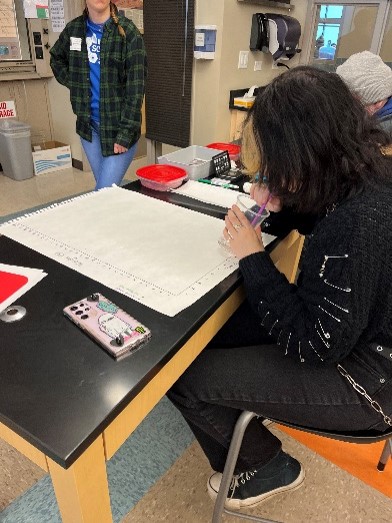
Dean Morgan Middle School Casper
On April 3rd and 4th the Roadshow took off to Casper again to visit with 270 Dean Morgan Middle School 8th grade students to do activities linked with electricity and magnetism. Unfortunately, due to a record breaking storm our team was only able to visit with about 60 of the students before snow restricted our ability to stay and engage. While with the students, the Roadshow team did a number of fun, interactive activities with the students. They started by covering just magnetism by having the students complete experiments related to magnetic strength and measuring magnetic fields. They then explored the concept of electricity by doing a number of demonstrations including circuit balls and battery polarity. The students were then able to work in groups to build their own penny battery (lesson compliments of the UW Science Kitchen)! After exploring these two concepts separately, the students connected them together by engaging in electromagnetism by building their own motor using copper wire, a battery, tape, paperclips, and magnets.
****************************************************************************************************
Roadshow Team:
Katie Davis (Graduate Student in Program in Ecology)
Alyssa Baldwin (Graduate Student in Rangeland Ecology and Watershed Management)
Quiana Jeffs (Graduate Student in Neuroscience)
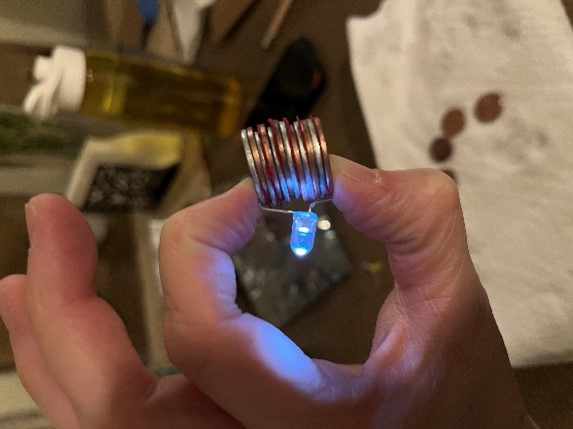
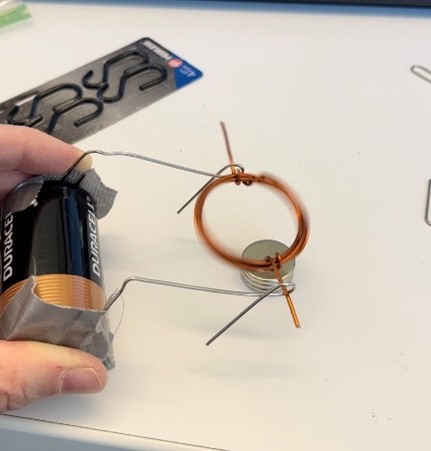
Laramie High School Psychology
The Science Initiative Roadshow were back with the Laramie High School Psychology students on March 28th and 29th for two fun days about the brain in partnership with the international Brain Awareness Week campaign by the Dana Foundation. During the visit, 115 high school students were able to warm up with a game of kahoot about the brain before splitting into stations where they got to explore the different senses of the brain. The students were able to operate a robotic claw with their neural impulses, modify their sense of taste with miracle berries, test their focus with the functional near-infrared spectroscopy device by Mendi, guess the brains of different animal species, and learn about their visual system and coordination with prism goggles. After the stations, the students went through a simulated alien invasion and attack on the brain circuits of human emotions. They had to work together in teams to design a drug to either fight off the aliens’ plans or to help the aliens attack the emotions of the brain!
****************************************************************************************************
Roadshow Team:
Quiana Jeffs (Graduate Student in Neuroscience)
Levi Flom (Graduate Student in Neuroscience)
Austin Bernard (Undergraduate Student in Mechanical Engineering)
Kinsale Day (Undergraduate Student in Geology & Geophysics)
Max Packebush (Undergraduate Student in Molecular Biology)
Elizabeth Lungren (Undergraduate Student in Molecular Biology)
Karagh Brummond (Faculty Science Initiative and Director of SI Roadshow)
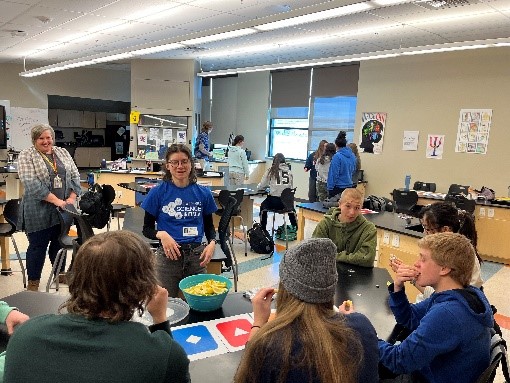
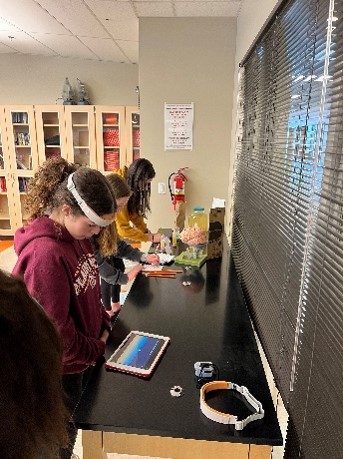 |
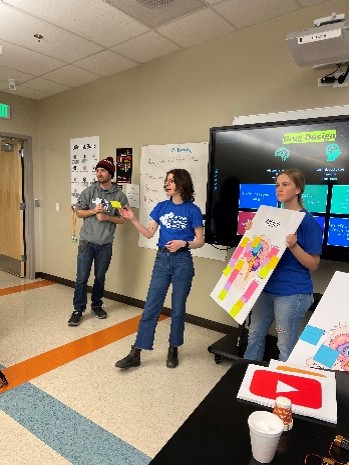 |
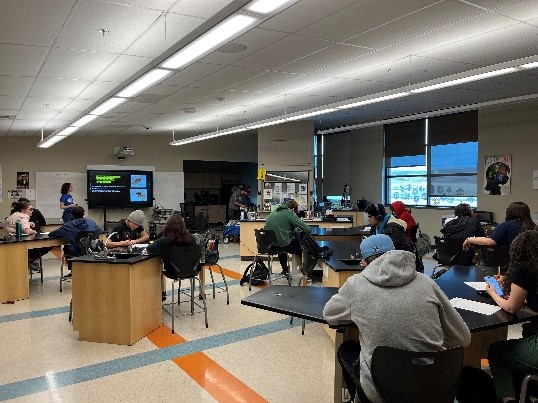
Central High School Cheyenne
On March 22nd, the Roadshow drove over the mountains to Cheyenne Central high School where we spent two class periods with 40 total psychology students doing interactive activities about the brain. We started with a DIY Kahoot to get the students warmed up with commonly misunderstood questions about the brain. The students then split into rotation stations where they were able to: 1) trick their sense of taste with miracle berries (turning sour into sweet); 2) try on prism goggles and test their coordination and brain plasticity; 3) learn more about how prosthetic limbs work through interacting with the robotic claw; and 4) getting to experience actual brain specimens from different animal species and test their neurofeeedback skills related to attention and focus with Mendi. After station rotations and hands-on activities, the students then performed a group activity where they learned about the brain processes related to emotion. They were then faced with a challenge of protecting (or attacking) humans from an alien invasion where aliens were designing a drug to hijack the emotional circuits of the brain. The students worked in groups to either design the drug to attack the humans, or find ways to protect ourselves again the invasion. The students then culminated their responses on large boards of the emotional circuits of the brain. We then compared how the protective drug would, or would not, withstand against the alien’s plan.
****************************************************************************************************
Alyssa Baldwin (Graduate Student Rangeland Ecology and Watershed Management)
Kathryn Sandum (Graduate Student Biomedical Sciences)
Austin Bernard (Undergraduate Student Mechanical Engineering)
Karagh Brummond (Faculty Science Initiative, Roadshow Director)
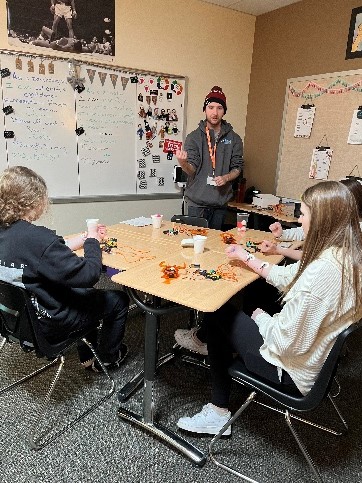 |
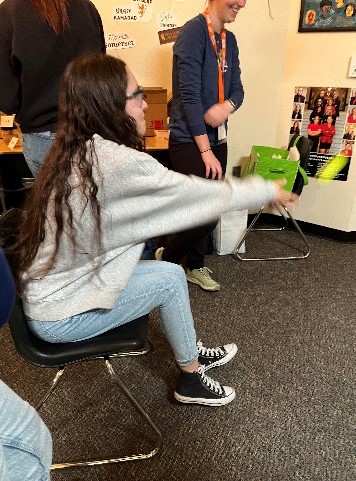 |
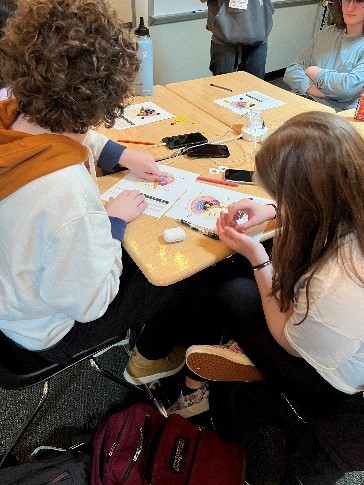 |
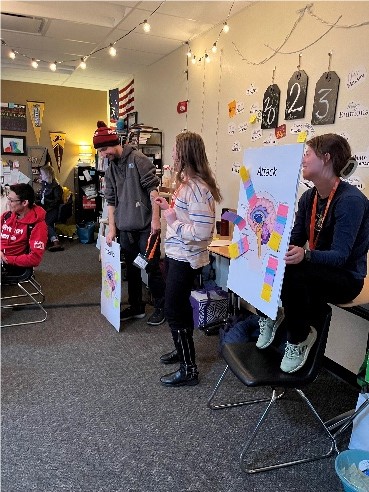 |
Franklin Park Elementary School (Virtual)
On March 8th, Karagh Brummond, Director of the Science Initiative Roadshow, spent the day virtually visiting 90 students at Franklin Park Elementary school in central New Jersey. The 3-5th grade students were celebrating International Women’s Day by inviting a variety of national women speakers to zoom into the classroom and talk about their career journey and specialties. The school counselors found Karagh’s profile on FabFems (Karagh Brummond | FabFems) and invited her to participate this year. Karagh spent 30 minutes with each class talking about her academic journey as a neuroscientist and sharing her current day-to-day life in her career.
****************************************************************************************************
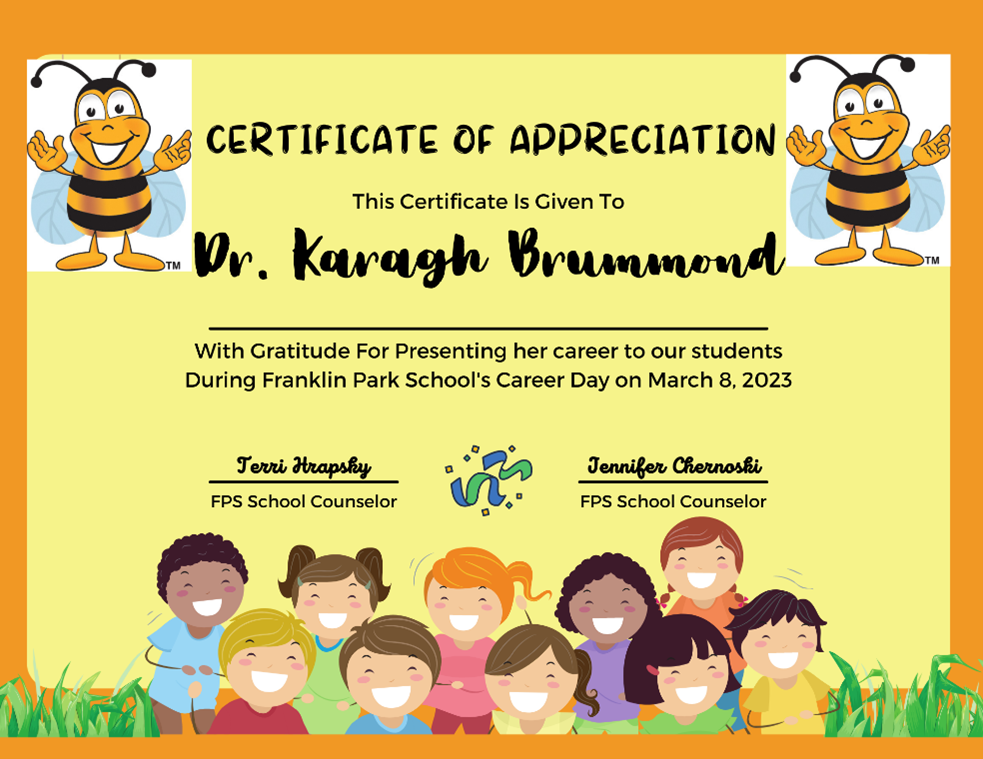
HEM STEM Day Hanna
On Friday, February 17th 160 students from both the Hanna, Elk Mountain, Medicine Bow elementary and junior/senior high schools came together for a STEM Day! The K-12 students rotated through 10 different STEM stations where they were able to spend about 30 minutes exploring a topic in the sciences with hands-on activities. The Roadshow team led 7 of these stations while the local FFA ran 3 of the remaining sessions.
In the neuroscience room with Karagh Brummond (director of the SI Roadshow), the students learned about the different parts of the brain and looked at actually animal brain specimens to determine how brain structure relates to behavior and function. After reviewing these concepts, the students broke into small groups where they worked together to design, draw a new animal of their choice, and then sculpted the animal’s brain out of playdoh based on the behaviors they wanted their animal to have in the wild.
Students then learned about DNA and genetics with graduate student Katie Davis (graduate student in the Program in Ecology). The student discussed what DNA is and what it does then got their hands dirty by extracting DNA from strawberries. The students then talked about the processes that can affect genetic diversity in populations, using M&Ms as a model, and connected those processes to questions about endangered species and other conservation concerns.
To practice engineering skills, the students embarked on a design challenge with Kathryn Sandum (graduate student in Biomedical Science)! This engineering station involved discussing what it means to engineer something, including identifying a problem, planning a design, and testing the prototype to make improvements. Students implemented these skills by building bridges, cars, towers, and airplanes from recycled materials and then their builds were tested with normal and “Wyoming level” winds!
Students combined ideas of building and designing with physics as they explored roller coasters in our physics activity with Liz Lungren (undergraduate student in molecular biology). For this activity, the students put their knowledge of potential and kinetic energy to the test. Each group of students were given a marble, tape, and tubing then asked to demonstrate both kinetic and potential energy through the construction of a creative, working roller coaster.
In the electricity room with Lauren Kim (graduate student in Physics and Astronomy), the students talked about static electricity and how we create static electricity. The students then saw a demonstration of the behavior of electrons and had the students play/experiment with a van de graaff generator. The generator also demonstrated the ionization of air (bright sparks and snapping sound when “getting shocked”). The students also used LED lights to try and figure out how to light up an LED using a van de graaff generator to understand the flow of charges better.
Graduate student Alyssa Baldwin (Program in Ecology) led our STEM room on “Wetland Ecology.” The students used paint pins covered in clay to form a makeshift slope/farmland. They then used sponges as the wetlands because they can hold water as an easy-to-understand figure. Students then conducted experiments with and without the sponge and sprayed water on the slope/clay. They were asked about pollution and used laundry soap as a pollutant for an easy sud identification. The Students could tell the wetlands (sponges) collected that pollution when tested which really highlighted the importance of wetlands in our environment.
In the final room, Austin Bernard (undergraduate student in engineering) had the students learning about trees. The lesson was about the stories that trees tell. To start, the students learned some interesting facts about trees and then discussed the different parts of a tree cross-section. They talked about the cambium layer, how new tree rings and cells are formed, and their purpose in the tree. For example, the formed tree cells act as straws that carry water up to the canopy, and depending on the time of year those cells would be big or small. This led to the first activity of modeling their own tree rings using the structures provided and various diameter straws. The model was used to show the wet and dry seasons in a tree ring as well as if it was a wet or dry year. After the activity the students looked at cross-sections of actual trees and identify different sections of the tree as well as counted the tree rings. Finally, the students saw some unique cases of cross-sections that had fire damage on some of it that cause the cambium layer to stop producing new cells in that area. The surviving cambium grew cells that encompassed some of the dead parts and made a weird shape. The last cross-section had a small strip in a fire scar where the cambium layer was not killed and it grew a ball shape on top in between the fire scars.
This is the second year the Roadshow has participated in the STEM Day at HEM and we look forward to future collaboration with this school and others who look to implement the power of STEM Days in their schools and communities.
****************************************************************************************************
Roadshow Team:
Katie Davis (Graduate Student Program in Ecology)
Alyssa Baldwin (Graduate Student in Rangeland Ecology and Watershed Management)
Kathryn Sandum (Graduate Student in Biomedical Sciences)
Austin Bernard (Undergraduate Student in Engineering)
Elizabeth Lungren (Undergraduate Student in Molecular Biology)
Lauren Kim (Graduate Student in Physics and Astronomy)
Karagh Brummond (Faculty Science Initiative and Director of the SI Roadshow)
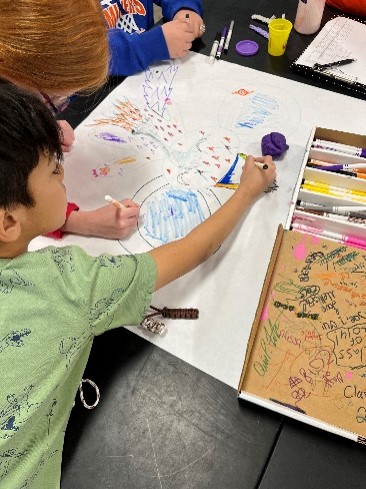 |
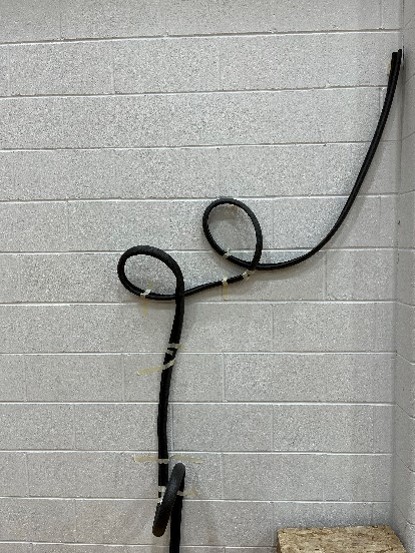 |
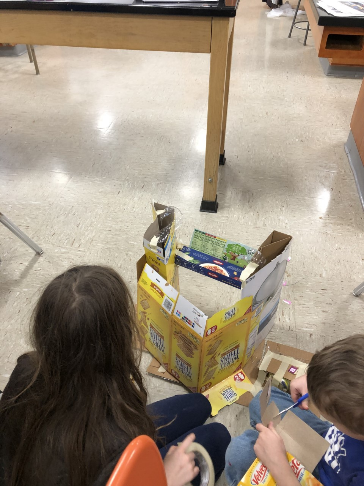 |
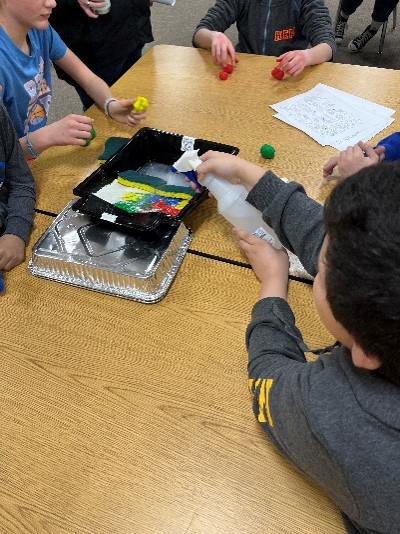 |
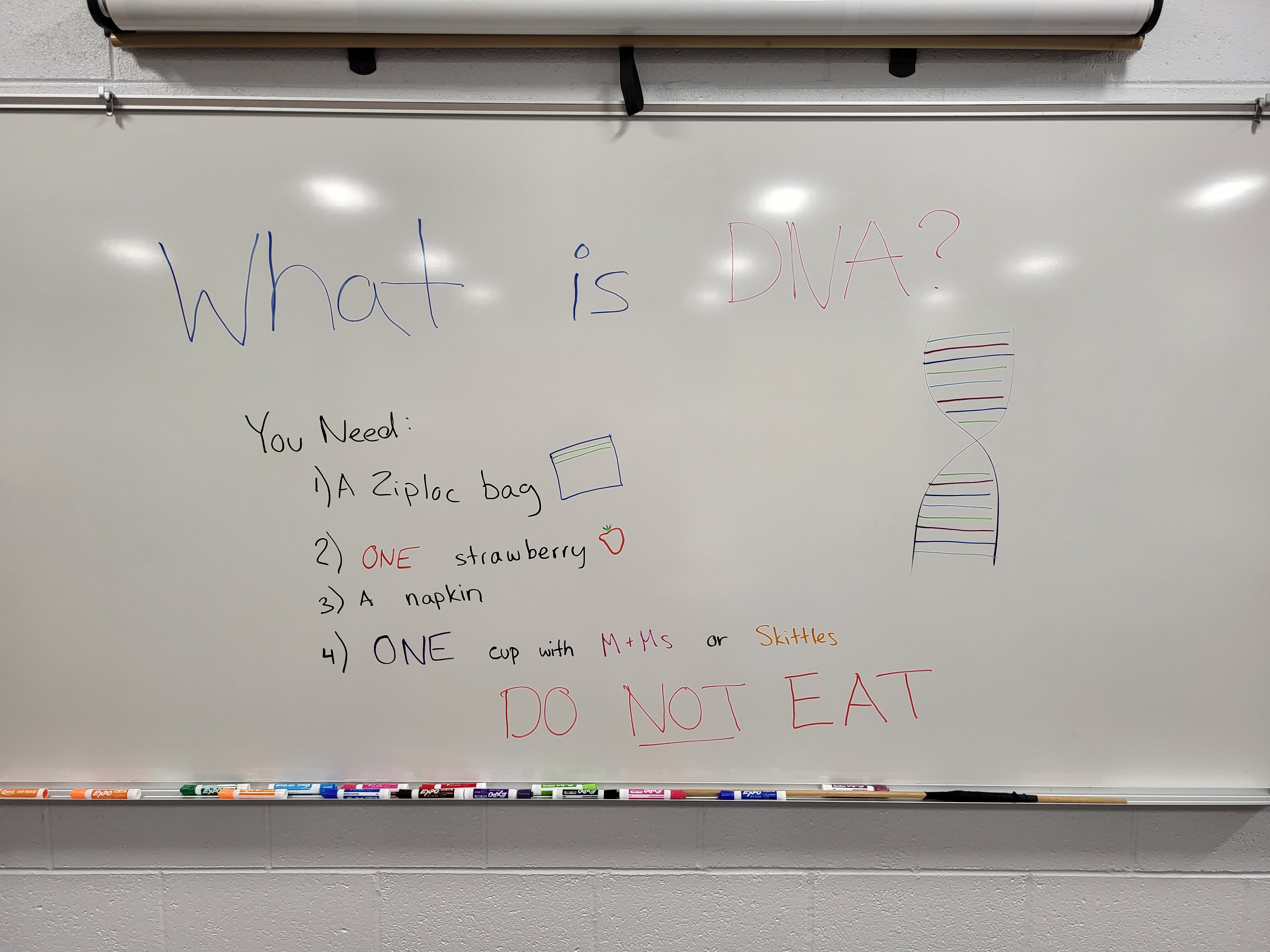
Dean Morgan Middle School Casper
On Thursday, January 26th the Roadshow team visited with 110 6th grade students from Dean Morgan Middle School in Casper. The students were about to begin their unit on gravity and types of energy so the roadshow developed two hands-on activities to link the concepts of gravity with kinetic and potential energy. The students began by talking about the conservation of energy and what kinetic and potential energy are in a system. They then expanded on the idea of potential energy identifying the ideas and concepts of gravitational potential energy. The students then determined how gravity, mass, and height play a role in gravitational potential energy by performing a ball drop experiment. The students worked in groups to weigh and test two different balls which they dropped from three different heights, timing how long it took the ball to hit the ground. After collecting their data, the students shared how height and mass of the balls impacted their gravitational potential energy and kinetic energy. After working through these concepts, the students then talked about how these two forms of energy are conserved in a system like a roller coaster. The students then worked in their groups to build and create a marble roller coaster and tested where in the system they had to most potential and kinetic energy. We then ended relating the concepts to gravity by talking about what changes we would have to make to the roller coasters if they were brought to the Moon where there is roughly 1/6 the amount of gravity compared to Earth.
****************************************************************************************************
Roadshow Team:
Kathryn Sandum (Graduate Student Biomedical Sciences)
Quiana Jeffs (Graduate Student Neuroscience)
Karagh Brummond (Faculty Science Initiative)
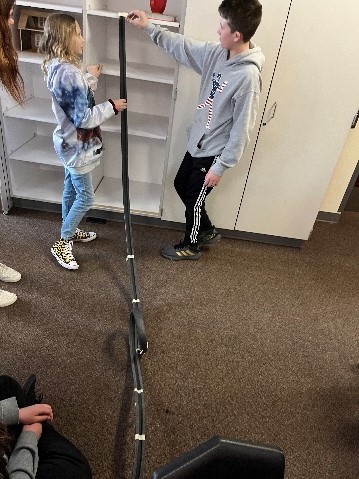 |
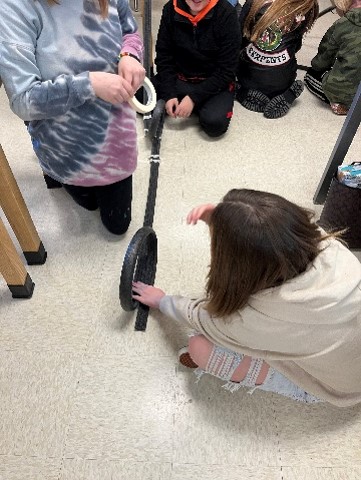 |
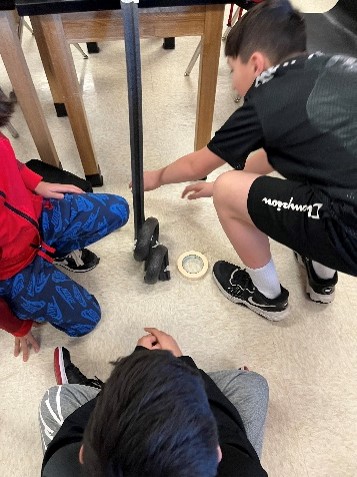 |
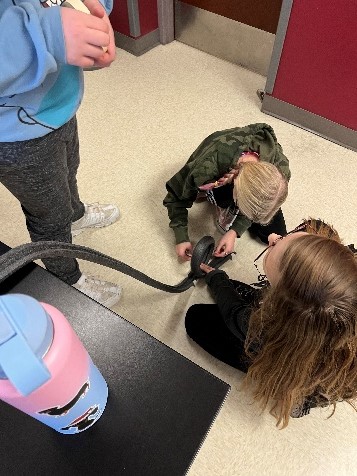 |
Powell Middle School
On January 11th and 12th the Roadshow collaborated with the NASA Space Grant Consortium and Science Kitchen to offer hands-on activities at the Powell Middle School linked with the 6th graders Artemis 1 research projects. The activities reach 127 students in Powell across a two day event. During class, the students were able to take part in three activities that taught them about radioactive decay and shielding. In the first activity, the students looked at a model of radioactive decay using red M&Ms to represent unstable atoms of an element called “Candium”. As time passes, the unstable atoms decay to stable atoms (green M&Ms). The students graphed the results and discussed the idea of random nature of the decay as well as applications to radiocarbon dating. In the second activity, students were able to use cloud chambers to experience the phenomenon of radioactive decay. The students observed tracks created in a cloud chamber by ionizing radiation as it passes through a cooled, supersaturated alcohol vapor. The final activity used a variety of provided materials so the students could build their own radiation shield which was then tested using a radioactive source and a Geiger counter. The students discussed applications of the radiation shield to space travel and tested to see which groups shield was most effective. See a story on this outreach from the Powell Tribune: NASA rep visits Powell Middle School | Powell Tribune
****************************************************************************************************
NASA/Roadshow Team:
Megan Candelaria (Associate Director NASA Space Grant Consortium, Science Kitchen Director)
Buck Scougale (Graduate Student Physics and Astronomy)
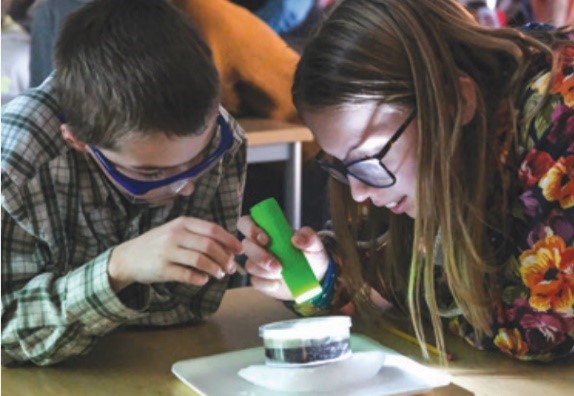
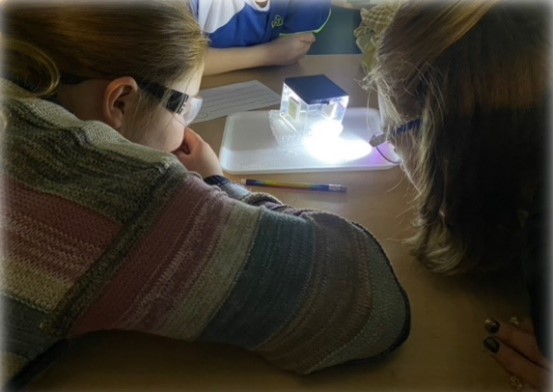
|
|
Skyline Academy Pinedale
On Tuesday, January 10th the Roadshow Team visited with 7 students at the Skyline Academy alternative high school in Pinedale, Wyoming. The students were working on their first sheep brain dissection as part of their human body unit. The Roadshow came to help with activities linked with the different regions of the brains and then helped the students through the sheep brain dissections. We began with activities linked with each of the lobes of the brain including optical illusions, taste and hearing tests, memory tests, and critical thinking games. The students then got the opportunity to play with a robotic claw using the neural signals to their muscles and then learned about their cerebellum by doing a prism goggle experiment. We talked and viewed the brains of a number of different animal species, then began the sheep brain dissection. The students identified many locations on the brain and then spent time exploring and asking questions about what they were seeing.
****************************************************************************************************
Roadshow Team:
Quiana Jeffs (Graduate Student Neuroscience)
Karagh Brummond (Faculty Science Initiative)
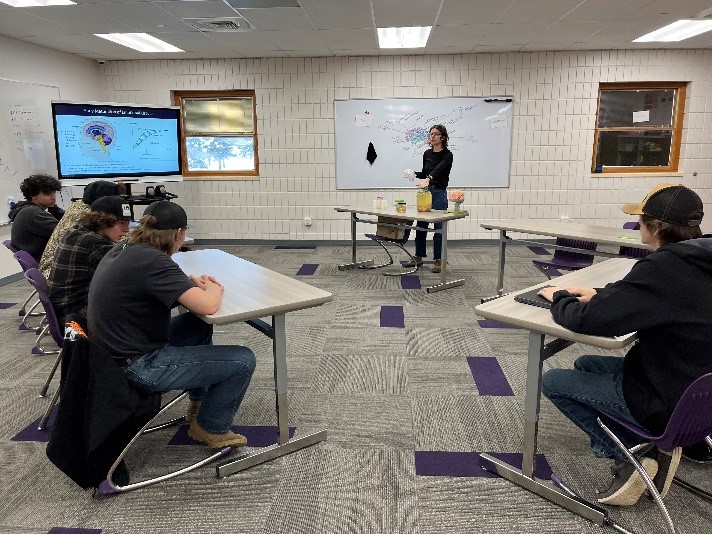
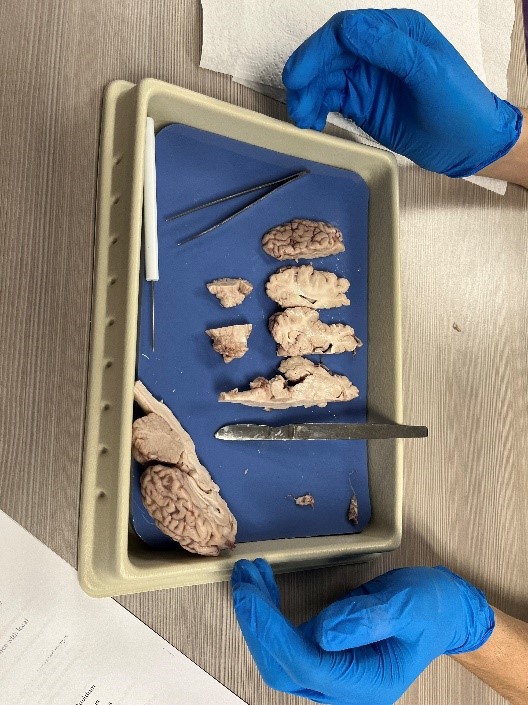
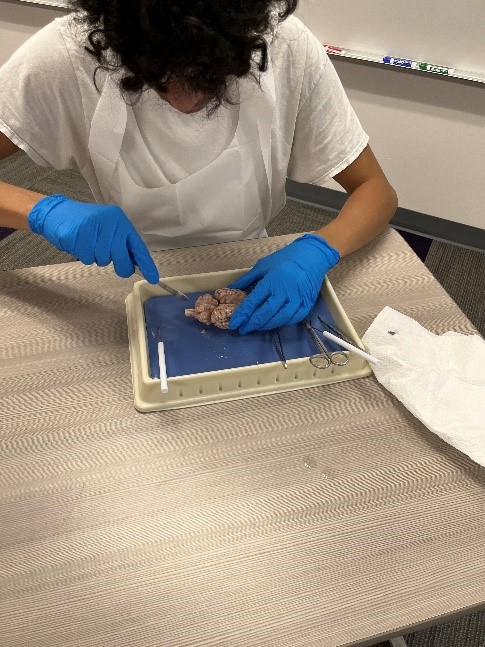 |
Pioneer Park Elementary School
On January 6th, the Roadshow team visited with 45 6th grade students from Pioneer Park Elementary in Cheyenne, Wyoming. The two 6th grade teachers reached out to the Roadshow asking if we could help supplement their unit on body systems. The Roadshow designed a hands-on, interactive lesson on the nervous system and how it integrates with other systems of the body. The lesson started with a review of what the students know about the nervous system and then went into activities related to the two main parts of the nervous system, the brain and spinal cord. Students began by observing two spinal cord models where they could appreciate how the spinal cord works to relay information to and from the brain to the rest of the body. The students then observed the brains of seven different animal species guessing what brain belongs to which animal and then comparing and contrasting aspects of the brains. We talked about what the main regions of the brain do and elaborated on some of the similarities and differences the students observed about the animal brains. The students played games related to each brain lobe and then went into the main activity where they worked together in groups to create their own nervous system! Students received paper and markers to draw and design their animal and then some Play doh to sculpt the brain of their imaginary animal using what they learned about the different parts of the brain to complement the behaviors of their imaginary animal. We ended with a demonstration of “The Claw” where we used electrical signals being sent from the brain to the muscles of the arm to operate and move a robotic claw to demonstrate how the nervous system in integrated with other parts of the human body.
****************************************************************************************************
Roadshow Team:
Karagh Brummond (Faculty Science Initiative)
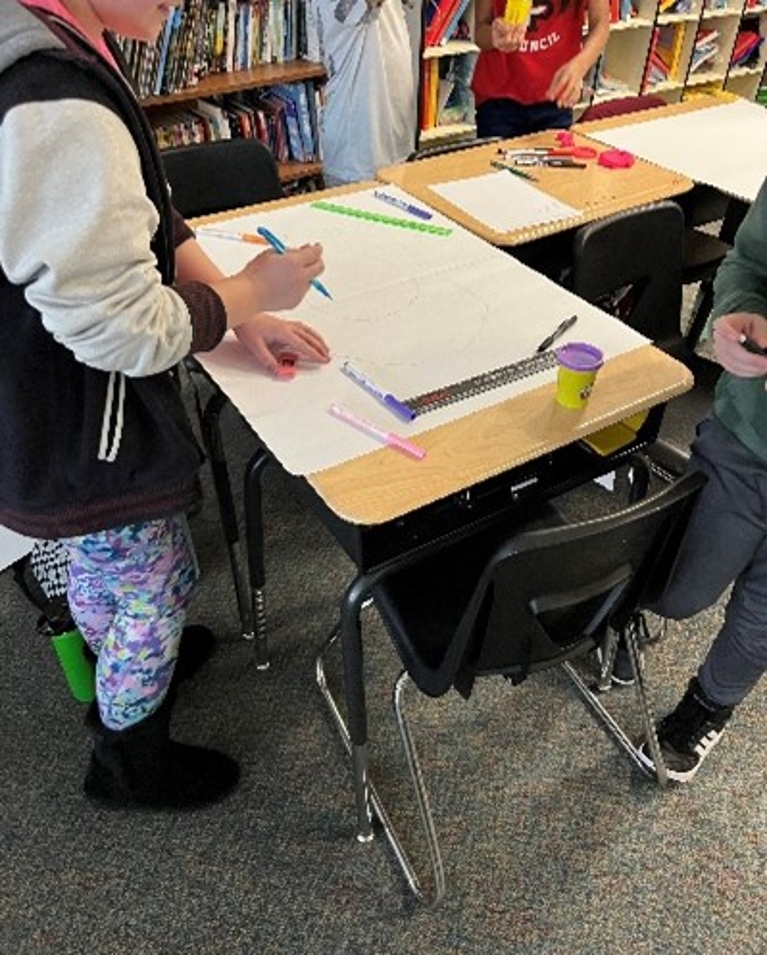
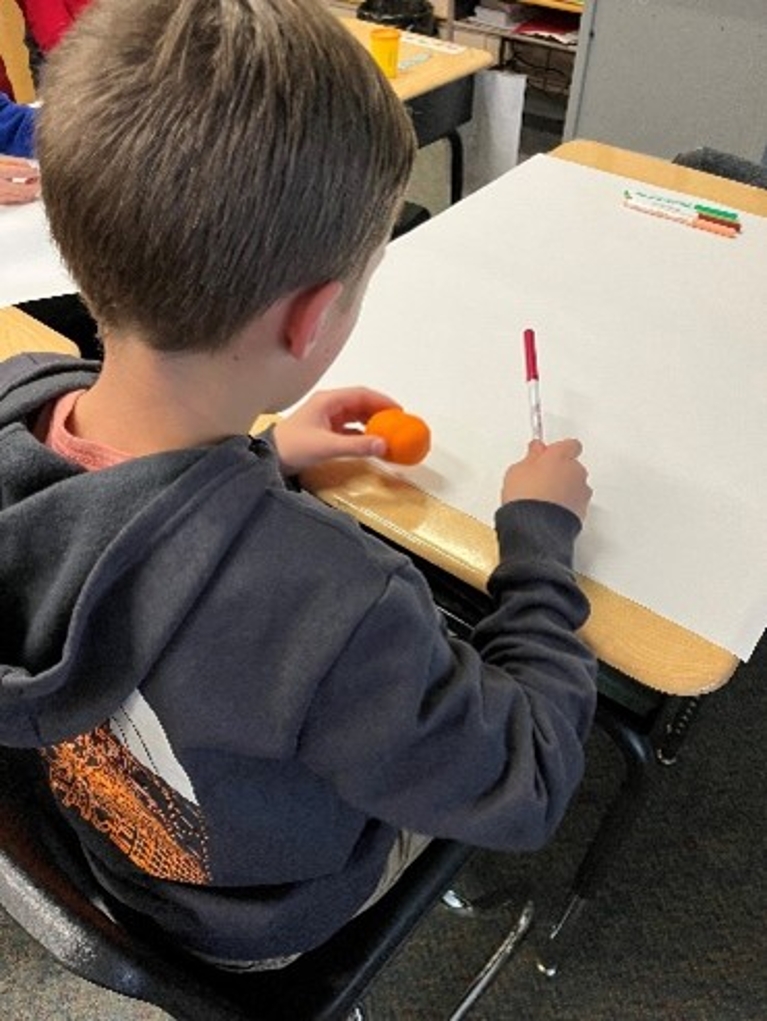
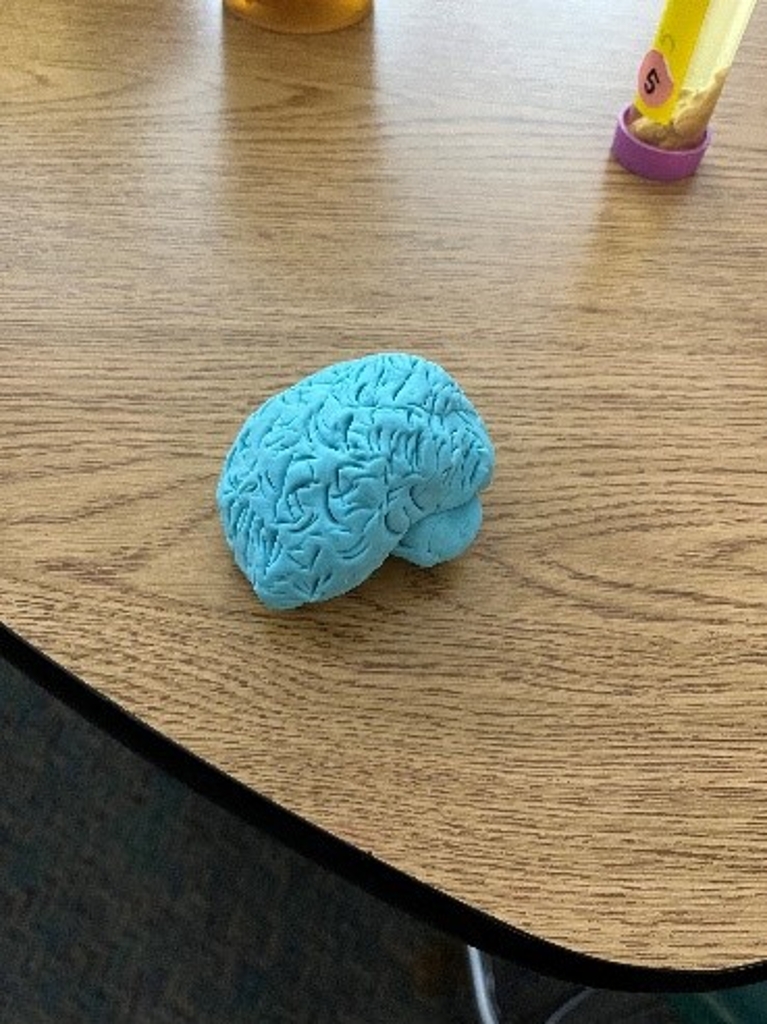
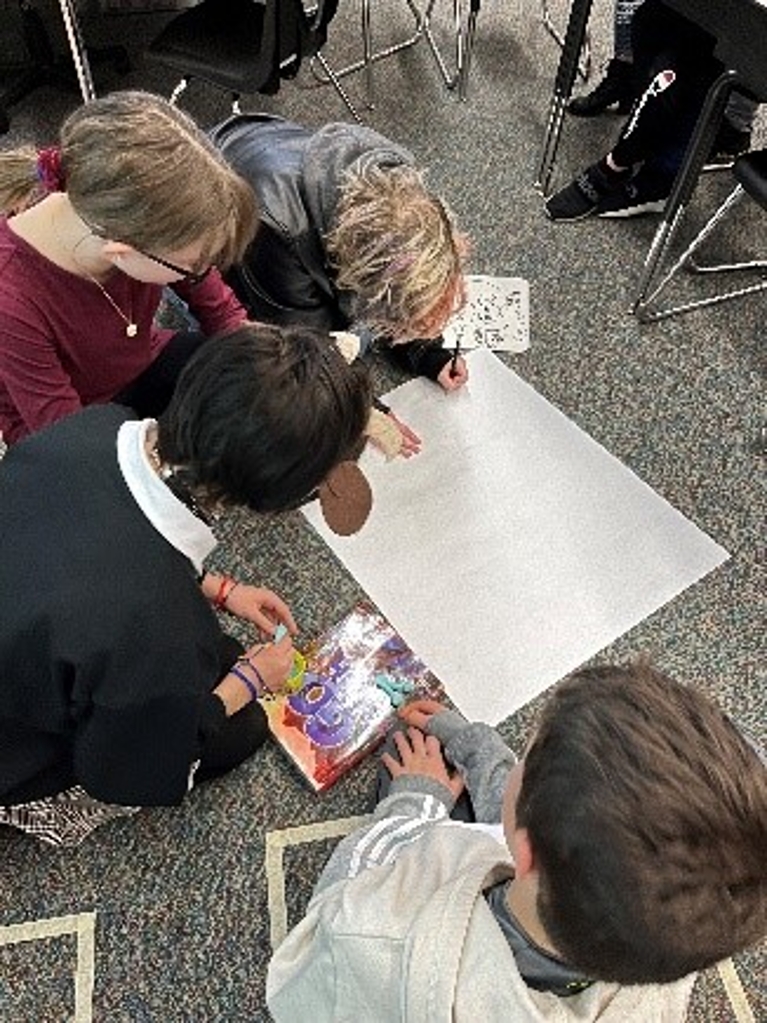
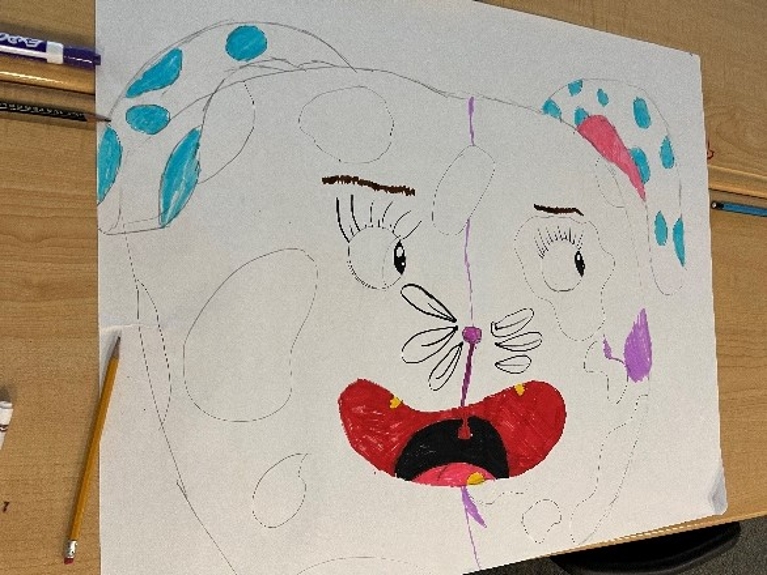
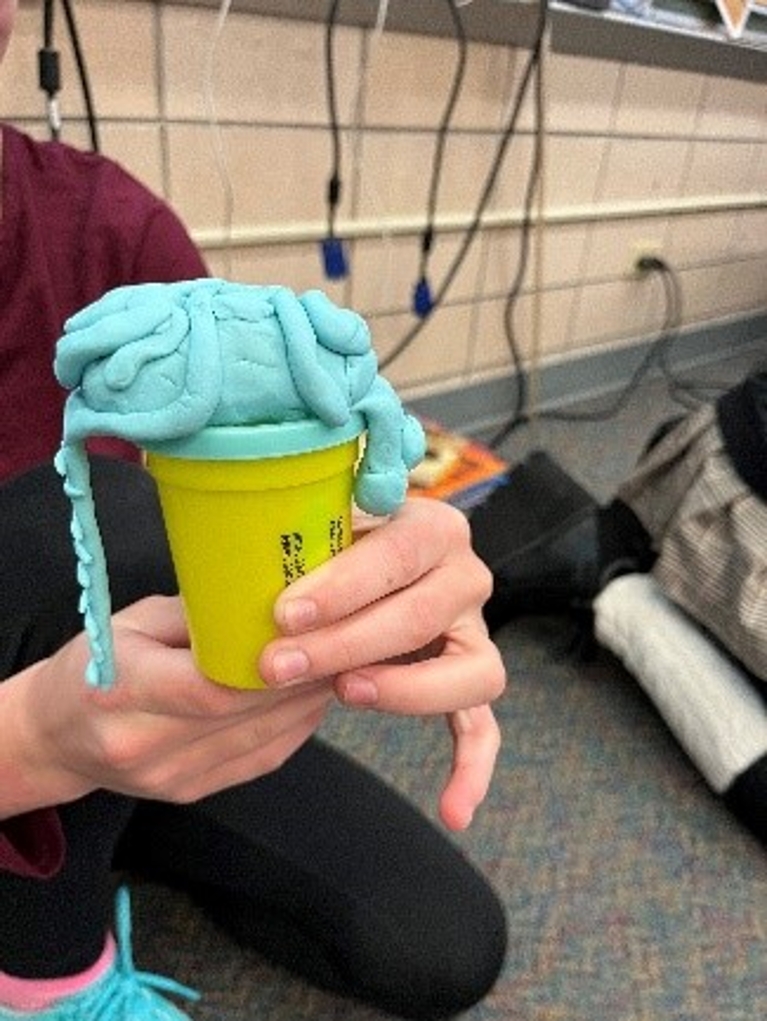
Laramie High School Earth Science
On Friday, December 9th the Roadshow team, led by graduate students Eva Smith and Ellen Polites, implemented plate tectonic activities for 220 Earth Science students at Laramie High School. The students began by asking the question of how and why the Earth is constantly changing. They then reviewed some concepts about the layers of Earth ending with the question of where the heat comes from within the Earth. To better understand this concept, the students made their own lava lamps with oil, alcohol, food coloring and water to demonstrate convection of molten rock in the mantle, and how it cools near the surface, falls towards the core where it gets heated up and becomes buoyant. The students learned about the different types of plate boundaries with an activity on divergent and transform boundaries. For divergent, students had to try and wrap paper around a balloon to show that encircling a round object (Earth) with something more rigid that can rip (crust) can cause divergent boundaries. Paired with convection of the mantle and subduction of plates, we get divergent plate boundaries/mid-ocean ridges. For transform boundaries, students used two graham crackers with frosting on them and a line of food coloring down the middle. The students then moved the crackers along side one another to demonstrate the movement of a transform boundary. They made observations and conclusions that centered on how transform boundaries work and how they stretch and rips Earth’s crust. We tied up this lesson by linking it back to how this affects human life on Earth by discussing earthquakes. As a final activity, students used slinkys to create and discuss p-waves and s-waves to understand how they are different, and they tie to the Earth’s layers. We also briefly discussed tsunamis and volcanoes linking plate tectonics back to how and why the Earth is constantly changing.
**************************************************************************************************
Roadshow Team:
Ellen Polites (Graduate Student Geology)
Eva Smith (Graduate Student Geophysics)
Austin Bernard (Undergraduate Student Engineering)
Elizabeth Lungren (Undergraduate Student Molecular Biology)
Quiana Jeffs (Graduate Student Neuroscience)
Kathryn Sandum (Graduate Student Biomedical Sciences)
Katie Davis (Graduate Student Program in Ecology)
Kinsale Day (Undergraduate Student Geography)
Karagh Brummond (Faculty Science Initiative)
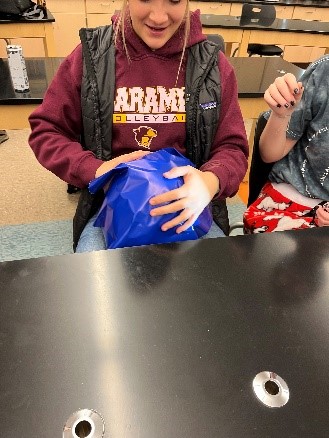 |
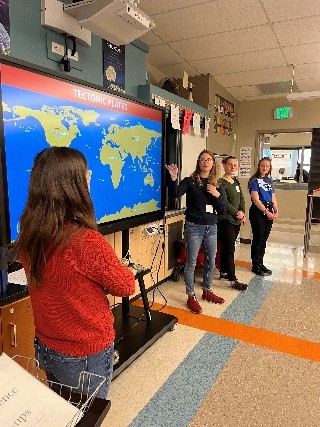 |
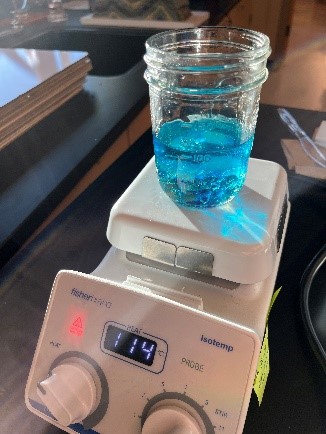 |
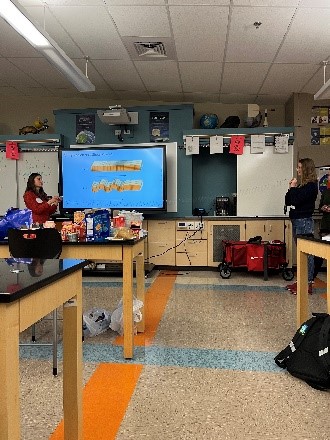 |
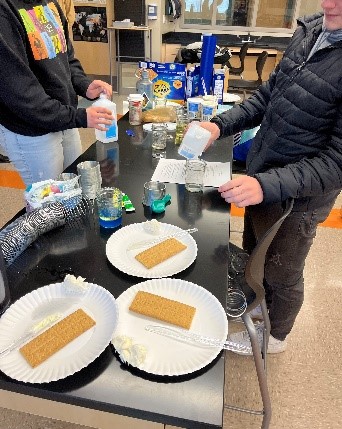 |
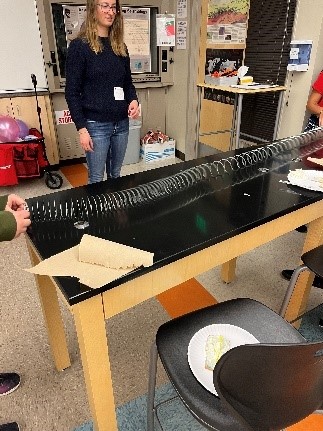 |
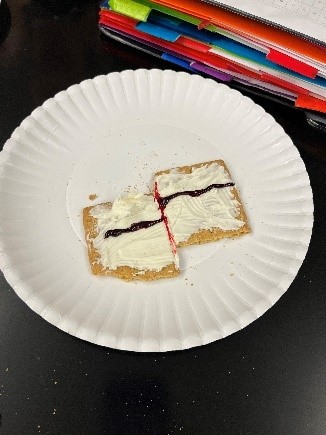 |
Laramie Middle School Physical Sciences
The Roadshow visited with 128 students from the 8th grade class at Laramie Middle School on Tuesday, November 29th and Wednesday, November 30th. The students were all in the Physical Sciences classes at the middle school and will soon be embarking on their own independent project using the Engineering Design Process. To help them practice and prepare for their project, the Roadshow designed an outreach lesson that allowed them to work in teams to use the Engineering Design Process to accomplish a “Recycling Challenge” where students worked in groups to use recycled materials to build either a tower, car, or bridge. Students went through the process as a class and then talked about what types of contact forces and other material from previous classes might impact their build. After identifying those forces, the students worked together to brainstorm their design, select their builds, and create a prototype. Once the prototypes were built, the students were able to test their designs against wind, earthquakes, and impact. The students also used an equation that factored in a rating of their creativity, aesthetics, utility, promotion of recycling, amount of time, and safety test results. Using this equation, the students performed their own self-evaluation of the build and then we had an inspector come and “grade” their design’s performance. The students were able to redesign and think about modifications that could improve their builds for the future. The builds are on display now at the Laramie Middle School library and a few photos of the student’s work are below!
****************************************************************************************************
Roadshow Team:
Austin Bernard (Undergraduate Student Engineering)
Elizabeth Lungren (Undergraduate Student Molecular Biology)
Quiana Jeffs (Graduate Student Neuroscience)
Kathryn Sandum (Graduate Student Biomedical Sciences)
Katie Davis (Graduate Student Program in Ecology)
Karagh Brummond (Faculty Science Initiative)
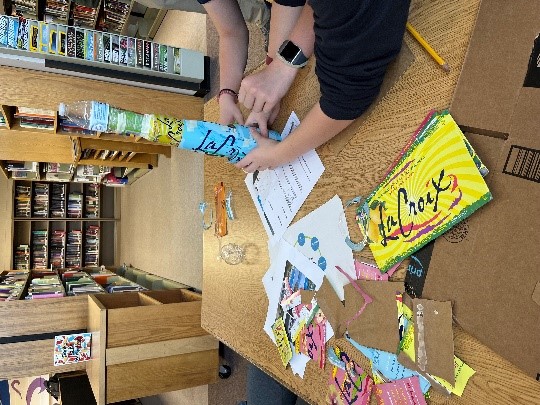
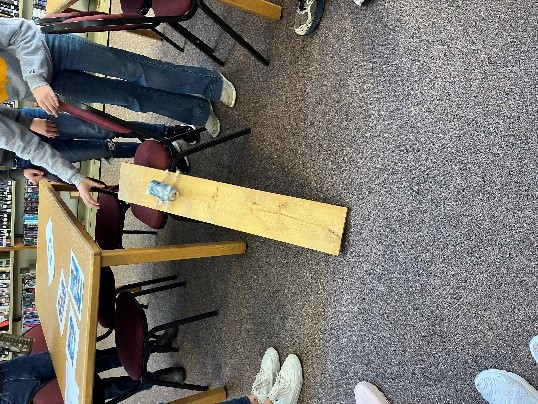
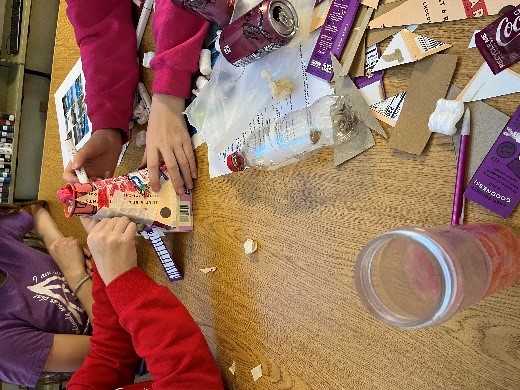
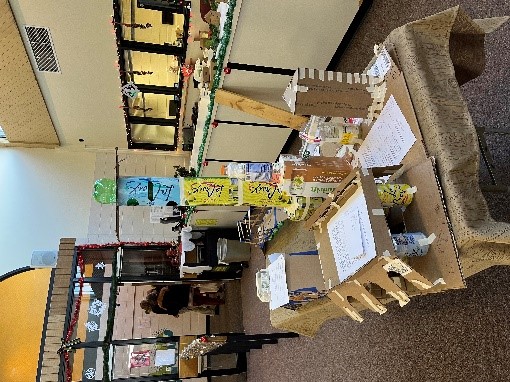
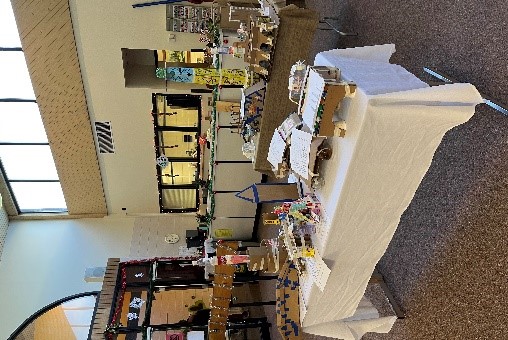
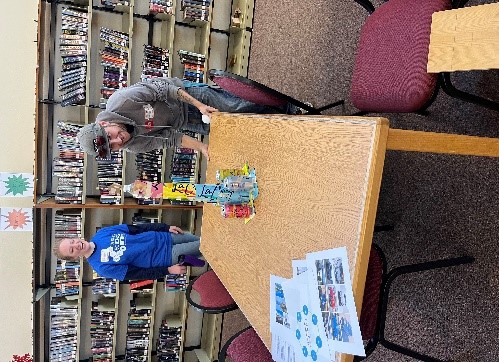
In-Reach: Dildine Elementary School (Cheyenne)
On October 18th, the Science Initiative Roadshow hosted 51 3rd grade students from Dildine Elementary School in collaboration with the UW Science Kitchen. The students used the Engineering Design Process to build, adapt, and create straw rockets. The students began by making observations about space shuttles and the features that help rockets distribute air flow. They then broke into small groups of 2-3 students each and received clay, tape, scissors, note cards, and straws to build and design their rockets. When they thought the built the best rocket, they went out into the hallway and propelled their rockets on the mini straw rocket launchers. We placed tape down where they rocket landed to keep track of the best rocket design. The students could then go back to the laboratory and modify their rockets based on the test to see if they could perform better on the next trial.
******************************************************************************************************
Roadshow Team:
Austin Bernard (Undergraduate Student Mechanical Engineering)
Elizabeth Lungren (Undergraduate Student Veterinary Sciences)
Kinsale Day (Undergraduate Student Geology)
Karagh Brummond (Faculty Science Initiative and Honors College)
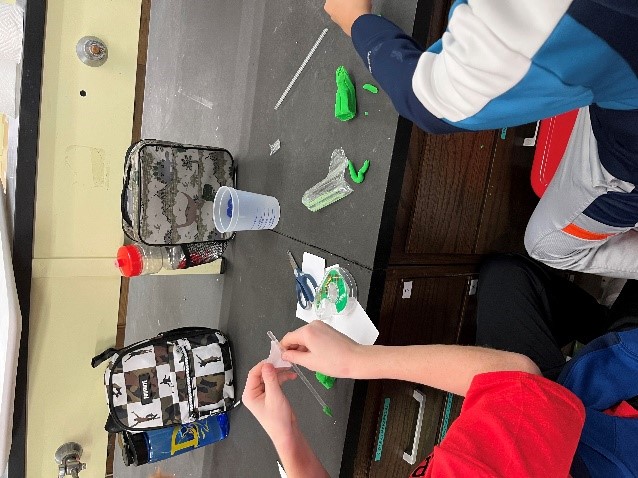
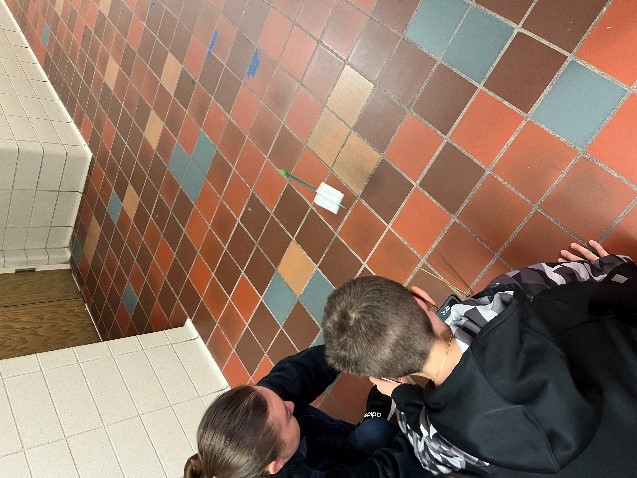
Laramie High School AP Psychology
On Tuesday September 27th the Roadshow visited with the AP Psychology students at
the Laramie High School to help 46 students dissect their first sheep brains! The
students are in the middle of completing their unit on neuroanatomy and asked the
Roadshow to come facilitate the student and teacher’s first sheep brain dissection.
The Roadshow worked together with the teacher to identify the key brain structures
the students should know and then collaborated on a worksheet for the students to
have during the dissection. When the Roadshow team entered the classroom, we helped
to drive the dissection by talking the students through the cuts needed to see the
different structures of the brain and asked the students probing questions about the
structures they were seeing. The students were extremely excited about their first
sheep brain dissections and the teacher felt more confident to lead the dissections
in the future.
********************************************************************************************************
Roadshow Team:
Quiana Jeffs (Graduate Student Neuroscience)
Austin Bernard (Undergraduate Student Mechanical Engineering)
Kathryn Sandum (Graduate Student Biomedical Sciences)
Karagh Brummond (Faculty Science Initiative and Honors College)
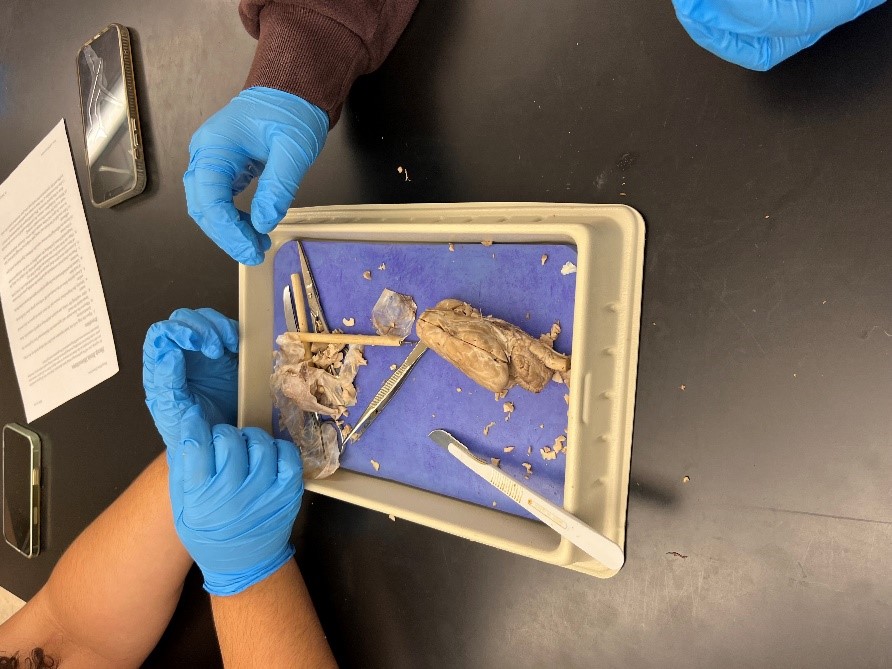
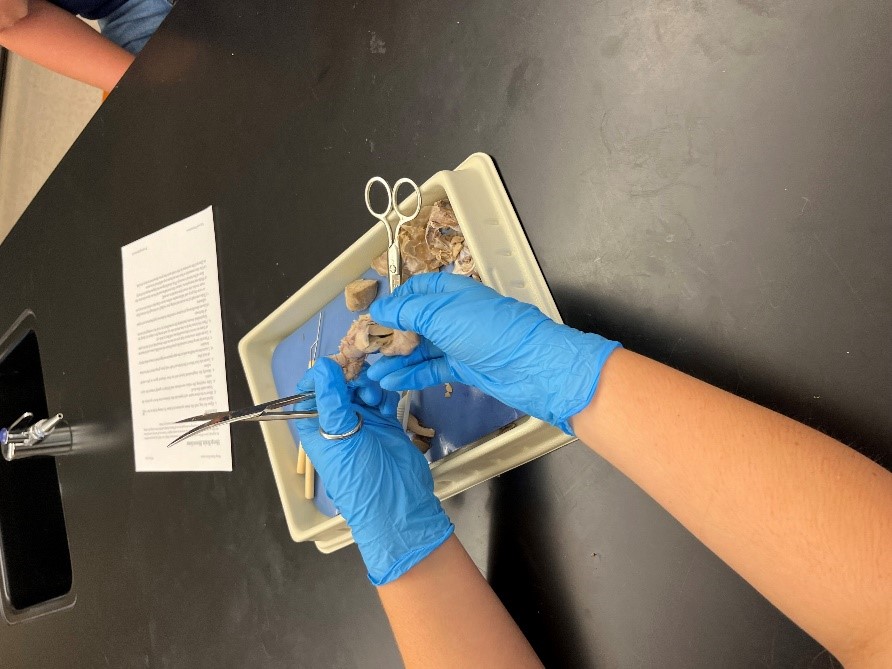
UW STEM CARNIVAL
On Friday, September 16th from 10am-3pm the Science Initiative and President’s Office
of Events hosted the first annual UW STEM Carnival and Grand Opening of the new Science
Initiative Building. The STEM Carnival had 37 STEM units from the University of Wyoming
campus and Laramie community who each offered hands-on activities at tables set up
inside and outside the new building. The carnival was attended by nearly 500 participated
including 168 K-12 students from Hanna, Elk Mountain, Medicine Bow schools, the UW
Lab School, and Cheyenne Central High School. Community members and K-12 students
engaged in interactive science activities that spanned the entire day and included
snacks and soft serve ice cream courtesy of the Chemistry department.
Quotes from Attendees Included:
"The STEM carnival was a wonderful learning opportunity for our students. I was overwhelmed
by the amount of rich, engaging activities for students to participate in. Allowing
students into the world of STEM is so important for their interests and learning.
From plants to jewelry making to bees to animal tracks to ice cream, the opportunities
were endless. Thank you again, it was AMAZING!" -K-12 Teacher
"It was really great. All the activities were fun. I loved the ice cream and watermelon
drop.” –H.E.M. Junior/High School Student
“Going to the carnival really made me appreciate the vibe of the whole university.
Thinking about how that’s just a snippet of the university really makes me happy because
it shows that everyone really cares about what they do. The sheer amount of passion
coming from every stand there was beautiful. Another thing that made me smile was
the number of kids there. Seeing young’uns genuinely enjoy themselves at the stands
I saw them at was great…. It’s really wonderful that UW has these programs, and it’s
even more wonderful that these programs are so good. Also, there were churros. I didn’t
have any, but I saw they were there. Having churros at an event automatically improves
the score out of ten by one, making my total rating of the event an 11/10.” – University
of Wyoming Undergraduate Student
A huge thank you to those groups who participated in the first annual STEM Carnival:
Plant Sciences
Biodiversity Institute
COPSE
Wyonics LLC
Van Diepen Lab
Monteith Shop - Haub School of Environment and Natural Resources
Physics Department and Society of Physics Student
School of Energy Resources
CEPS Dean's Office - Center for Student Success
WyGISC
Stable Isotope Facility
Chemistry
Rocky Mountain Herbarium
Wyoming State Science Fair
Family & Consumer Sciences
Molecular Biology
Geology & Geophysics
Wyoming INBRE
Science Kitchen
Science Loves Art
University of Wyoming Museum of Vertebrates
Wyoming NASA Space Grant
Ecology and Biogeochemistry Core Lab
Wyoming Migration Initiative
3D Visualization Center
School of Pharmacy
School of Computing
Kinesiology
Mobile Makerspace
Science Initiative Roadshow
UW Recycle Club
Alumni Association
UW Foundation
Admissions
Laughlin Lab
Murphy Lab
College of Agriculture, Life Sciences, and Natural Resources
Information
Weiss-Lehman Lab
Anthropology Museum
Geology Museum
Elliot Hulley and Navamoney Arulsamy (Arul) for demonstrations of the new X-ray diffractometer
Jack Leonhardt, Spencer Miller, and John Ackerman for use of the very popular ice
cream machine
Annie Bergman, Zhaojie Zhang, Katie Davis, Megan Candelaria, and Rachel Watson for
offering additional STEM activities
President Seidel, Carl Wieman, and Ellen Carano for offering plenary talks
Chip Kobulnicky for the amazing gravity demonstration using the watermelon drop
Mark Lyford and Greg Brown for guiding tours of the new Science Initiative Building
Numerous Wyoming Research Scholar students who volunteered their time for setup, take
down, and the information table
The President’s Office of Events staff and student interns
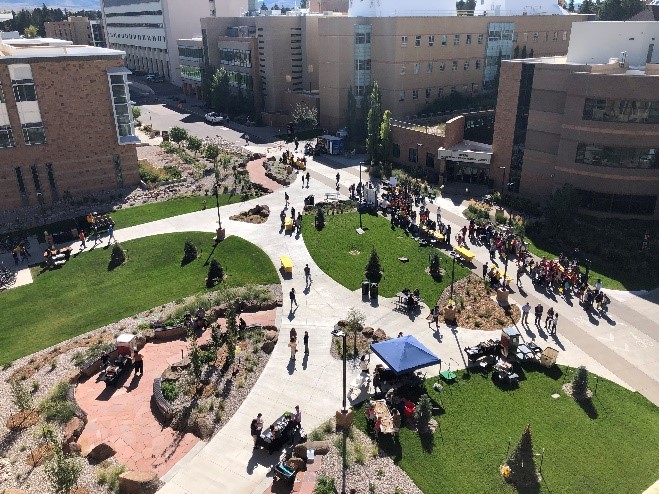
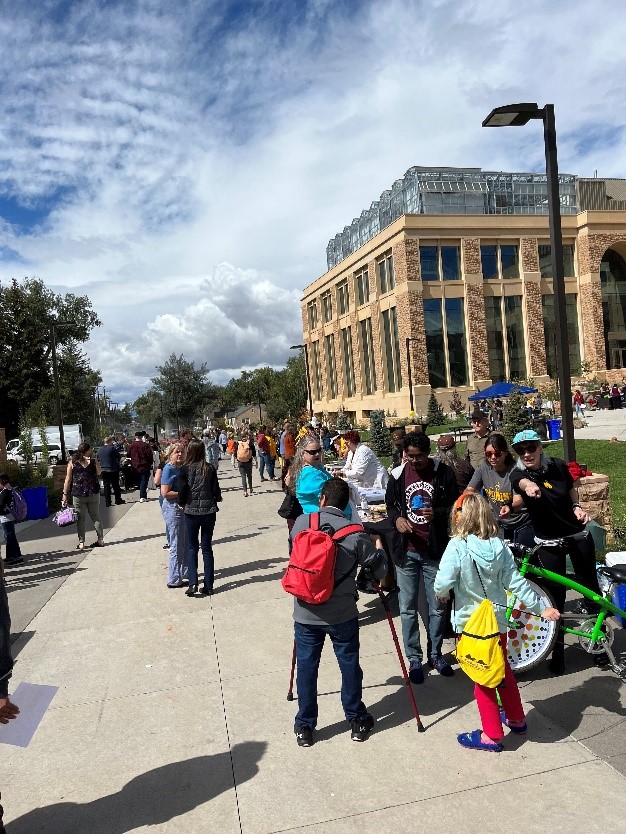
Davis Elementary School - Cheyenne
On July 6th the Roadshow took to I-80 to visit 14 third grade students at the Davis Elementary School in Cheyenne. The students were excited to do some hands-on STEM in their summer school classroom and the Roadshow team designed some activities to teach the third graders about their brains. This is the first time many of them were able to even begin to learn about the amazing organ that drives all our thoughts and behaviors. To help orient the students, the Roadshow team started by walking through each lobe of the brain while the students participated in interactive activities related to each lobe and located the lobe on their brain hats. The students spent some time coloring each section of the brain related to the lobe and activity. After the students assembled their brain hats, they then engaged in an experiment using vision distortion goggles to learn how the brain learns and adapts to allow us to perform all the activities we learned about in each lobe of the brain. We then ended by taking a look at some actual brain specimens to allow the students to compare and contrast the animal species and their brains based on what they know about the animals’ behavior.
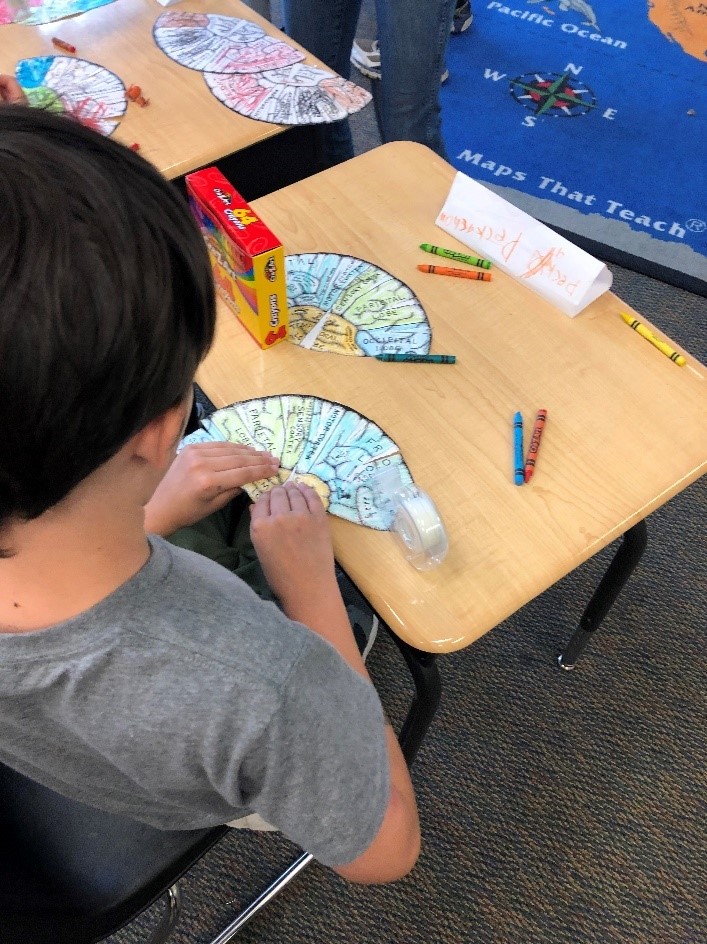
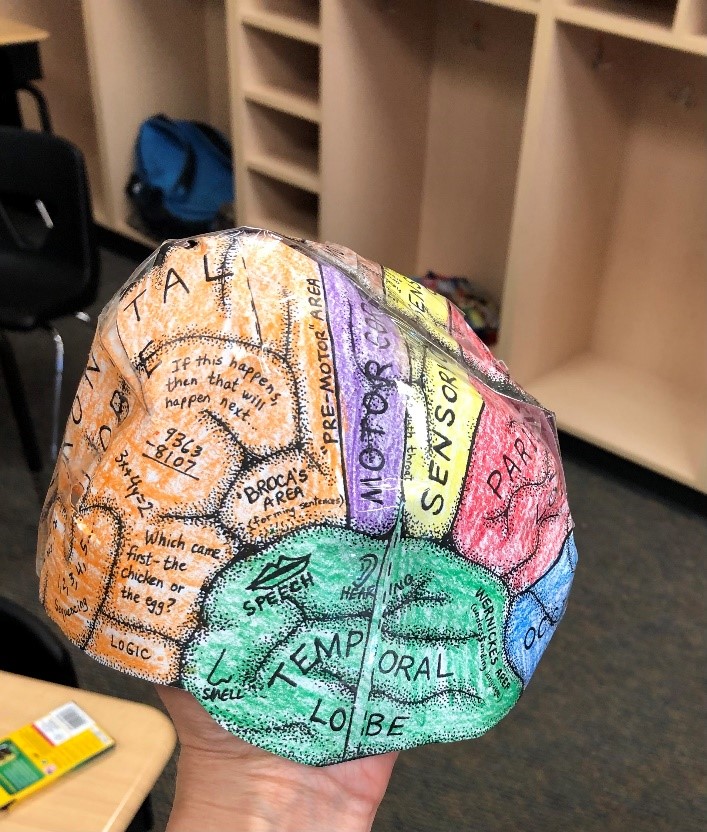
Contact Us
UW Science Initiative Engagement
Karagh Brummond
Email: kmurph17@uwyo.edu
Erin Klauk
Email: eklauk@uwyo.edu
Laramie, WY 82071

